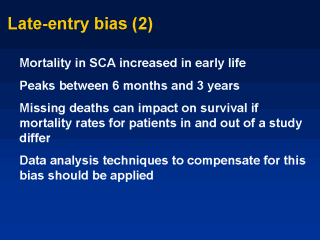 |
Mortality
in SS disease is increased in early life (1;2), with greatest mortality experienced
between the ages of 6 months and 3 years (3;4;5), and the possibility of missing
mortality, especially in early childhood, must be considered (6). Late-entry will impact
on survival estimates if mortality rates for patients in and out of a study are different.
Techniques to compensate for late-entry are applied during data analysis. References
(1) Rogers DW, Clarke JM, Cupidore L, Ramlal AM, Sparke BR,
Serjeant GR. Early deaths in Jamaican children with sickle cell disease. Br Med J 1978;
1(6126):1515-1516.
(2) Lee A, Thomas P, Cupidore L, Serjeant B, Serjeant G. Improved
survival in homozygous sickle cell disease: lessons from a cohort study. BMJ 1995;
311(7020):1600-1602.
(3) Serjeant GR, Serjeant BE. Management of sickle cell disease;
lessons from the Jamaican Cohort Study. Blood Rev 1993; 7(3):137-145.
(4) Gill FM, Sleeper LA, Weiner SJ, Brown AK, Bellevue R, Grover R
et al. Clinical events in the first decade in a cohort of infants with sickle cell
disease. Cooperative Study of Sickle Cell Disease. Blood 1995; 86(2):776-783.
(5) Leikin SL, Gallagher D, Kinney TR, Sloane D, Klug P, Rida W.
Mortality in children and adolescents with sickle cell disease. Cooperative Study of
Sickle Cell Disease. Pediatrics 1989; 84(3):500-508.
(6) Corey M. Survival estimates in cystic fibrosis: snapshots of a
moving target. Pediatric Pulmonology 1996; 21:149-150. |
